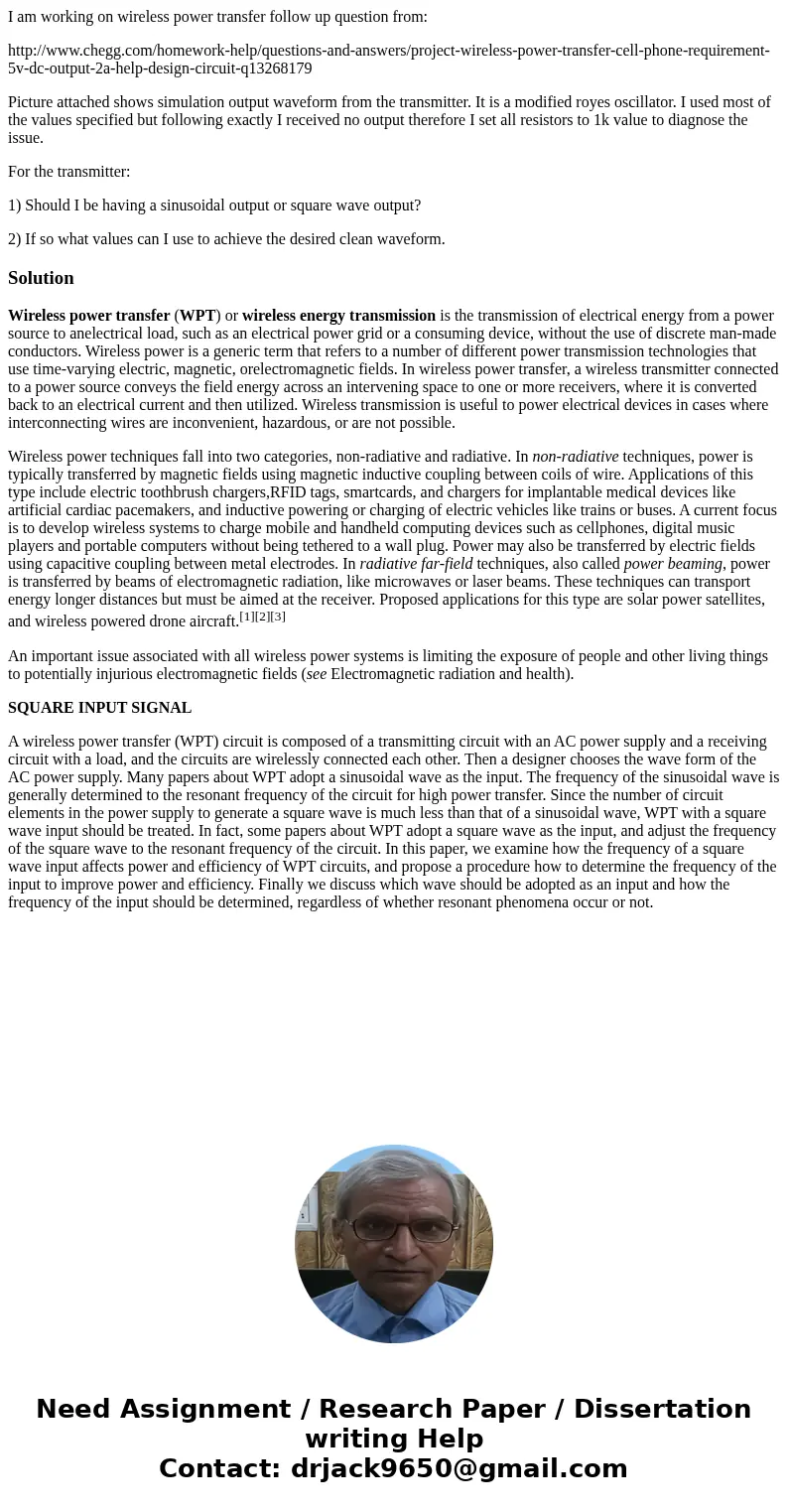I am working on wireless power transfer follow up question f
I am working on wireless power transfer follow up question from:
http://www.chegg.com/homework-help/questions-and-answers/project-wireless-power-transfer-cell-phone-requirement-5v-dc-output-2a-help-design-circuit-q13268179
Picture attached shows simulation output waveform from the transmitter. It is a modified royes oscillator. I used most of the values specified but following exactly I received no output therefore I set all resistors to 1k value to diagnose the issue.
For the transmitter:
1) Should I be having a sinusoidal output or square wave output?
2) If so what values can I use to achieve the desired clean waveform.
Solution
Wireless power transfer (WPT) or wireless energy transmission is the transmission of electrical energy from a power source to anelectrical load, such as an electrical power grid or a consuming device, without the use of discrete man-made conductors. Wireless power is a generic term that refers to a number of different power transmission technologies that use time-varying electric, magnetic, orelectromagnetic fields. In wireless power transfer, a wireless transmitter connected to a power source conveys the field energy across an intervening space to one or more receivers, where it is converted back to an electrical current and then utilized. Wireless transmission is useful to power electrical devices in cases where interconnecting wires are inconvenient, hazardous, or are not possible.
Wireless power techniques fall into two categories, non-radiative and radiative. In non-radiative techniques, power is typically transferred by magnetic fields using magnetic inductive coupling between coils of wire. Applications of this type include electric toothbrush chargers,RFID tags, smartcards, and chargers for implantable medical devices like artificial cardiac pacemakers, and inductive powering or charging of electric vehicles like trains or buses. A current focus is to develop wireless systems to charge mobile and handheld computing devices such as cellphones, digital music players and portable computers without being tethered to a wall plug. Power may also be transferred by electric fields using capacitive coupling between metal electrodes. In radiative far-field techniques, also called power beaming, power is transferred by beams of electromagnetic radiation, like microwaves or laser beams. These techniques can transport energy longer distances but must be aimed at the receiver. Proposed applications for this type are solar power satellites, and wireless powered drone aircraft.[1][2][3]
An important issue associated with all wireless power systems is limiting the exposure of people and other living things to potentially injurious electromagnetic fields (see Electromagnetic radiation and health).
SQUARE INPUT SIGNAL
A wireless power transfer (WPT) circuit is composed of a transmitting circuit with an AC power supply and a receiving circuit with a load, and the circuits are wirelessly connected each other. Then a designer chooses the wave form of the AC power supply. Many papers about WPT adopt a sinusoidal wave as the input. The frequency of the sinusoidal wave is generally determined to the resonant frequency of the circuit for high power transfer. Since the number of circuit elements in the power supply to generate a square wave is much less than that of a sinusoidal wave, WPT with a square wave input should be treated. In fact, some papers about WPT adopt a square wave as the input, and adjust the frequency of the square wave to the resonant frequency of the circuit. In this paper, we examine how the frequency of a square wave input affects power and efficiency of WPT circuits, and propose a procedure how to determine the frequency of the input to improve power and efficiency. Finally we discuss which wave should be adopted as an input and how the frequency of the input should be determined, regardless of whether resonant phenomena occur or not.

 Homework Sourse
Homework Sourse